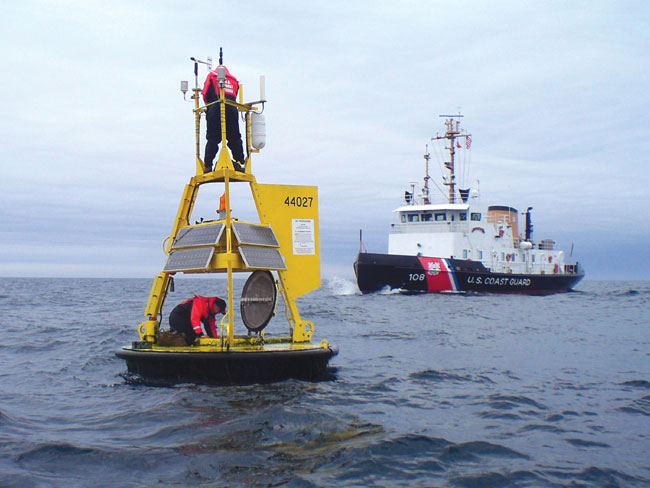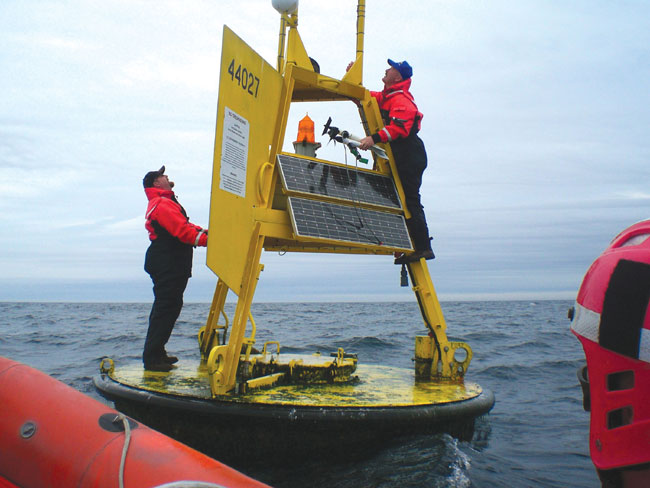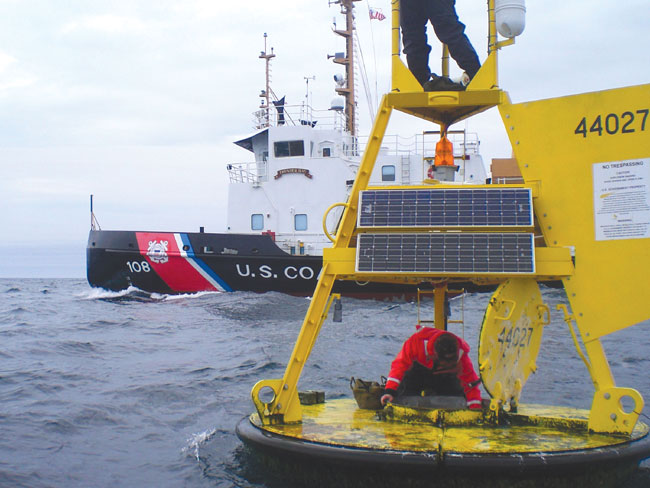Coast Guard cutter Thunder Bay assists National Data Buoy Center
By Lt. Thomas CraneOriginally Published by Knox County Times, The Waldo County Citizen, villagesoup.com used by permission.
ROCKLAND (June 18): On a recent cold and damp morning, a U.S. Coast Guard 25-foot rescue boat assigned to Station Southwest Harbor pulled alongside Thunder Bay, one of nine domestic ice breaking cutters in the Coast Guard fleet, as the ship departed Somes Sound near Mount Desert Island. The mission was to transfer two technicians from the National Data Buoy Center, located at Stennis Space Center in Mississippi, from the rescue boat to the cutter.
At 6:30 a.m., Thunder Bay was en route to the NDBC’s weather buoy 44027. The NDBC is an element of the National Oceanic and Atmospheric Administration responsible for maintaining numerous weather sensors throughout the country. NOAA maintains hundreds of offshore buoys that transmit weather data via satellite to their home base at the Stennis Space Center. That data is then disseminated to the public via the Internet and telephone recordings. Having the ability to access real-time weather conditions offshore allows mariners to make better educated decisions on whether it is prudent to sail or await improving conditions. NOAA buoy 44027 is located 40 nautical miles offshore south of Jonesport, ME.
NDBC funds and maintains the nation's numerous offshore weather buoys. NDBC does not, however, have a fleet of vessels to deploy or deliver personnel to maintain, repair and establish these buoys so the Coast Guard assists NOAA by providing that link. The buoys are a vital source of information used not only by mariners to ensure their safety, but also by weather forecasters to develop accurate forecasts by having as many real-time data locations as possible.
On this day, Thunder Bay transited to buoy 44027 with technicians Curtis Ladner and Kendell Lumpkin of the NDBC. The technicians drove from Virginia the day before and spent the night in Ellsworth prior to meeting the Coast Guard boat crew at Southwest Harbor.
Buoy 44027 was not functioning properly, in that it was not transmitting wind direction or velocity, barometric pressure, or proper wave height. The NDBC determined this by the satellite signals received from the offshore buoy. Thunder Bay arrived on the scene at buoy 44027 at 11 a.m. and prepared to launch the ship's 17-foot rigid hull inflatable boat to transfer the technicians to the buoy. The most crucial elements in the success of the operation depended on the cutter’s ability to safely launch and recover the rigid hull inflatable boat along with safely placing the technicians on the 9-foot diameter buoy bobbing on the sea. To accomplish that, Thunder Bay watched forecasts and monitored surrounding weather buoys to ensure the sea state (wave height) was less than 3 ft. Anything over 3 ft and the operation would become too risky to accomplish safely.

Figure 1. Rockland-based Coast Guard cutter Thunder Bay stands by in Jonesport near NOAA weather buoy 44027 while two NDBC technicians make repairs to the buoy damaged during April's nor’easter.
As the cutter approached the buoy, it was clear it had seen rough weather over the past two months as the anemometers had been stripped from the buoy's hull, likely due to significant wind velocities and wave heights.
The weather cooperated with Thunder Bay and the inflatable was safely launched with Ladner and Lumpkin aboard, along with three cutter personnel, including BMC Norm Santti, BM3 D.J. Holcomb, and FN Warren Harris, and a host of new parts bound for buoy 44027.
Once on board the buoy, Lumpkin climbed to the crow's nest to begin replacing the destroyed anemometers and Ladner opened the hold in the hull to replace wave height sensors and barometric pressure interfaces and inspect voltages on other equipment. Thunder Bay and the inflatable remained on station with the technicians to provide any support and additional parts needed, and ensure their safety should one of the technicians fall into the 47 degree Fahrenheit water.

Figure 2. With Thunder Bay's rigged-hull inflatable boat standing off NOAA buoy 44027, NDBC technician Kendell Lumpkin climbs to the crow's nest to replace two anemometers, which relay wind speed and direction to shore.
The current sea state was 2- to 3-foot waves with a northeasterly wind at 15 knots. The waves were just large enough to produce spray over the buoy as they made contact with the hull. This was not what Ladner was hoping for because once he opened the hold to the buoy, it was imperative that no water entered the hold due to the large number of sensors and electronics and batteries being held in the hold. Thunder Bay was positioned 50 yards upwind of the buoy to provide a lee, thus reducing the wave height to 1 ft and allowing the technicians to access the hold on the buoy without water intrusion.
After approximately one hour on station, Ladner and Lumpkin had completed the required repairs and were ready to be retrieved by Thunder Bay's inflatable boat. It safely removed the technicians from the buoy and made its approach alongside the cutter for retrieval. Once all the personnel and the boat were safely back on board, Thunder Bay was positioned downwind of buoy 44027 and maintained station while the NDBC technicians verified satellite transmission signals with their base operations at Stennis Space Center. Data is transmitted from buoy 44027 once an hour, so Thunder Bay remained on station for three hours to ensure the accuracy and quality of the transmission data.
With all tests and certifications completed, NOAA buoy 44027 was once again functioning as designed and providing mariners high quality real-time wind, wave and weather data. Thunder Bay then began the 40-mile transit back to Southwest Harbor to deliver the technicians to shore. Once inside the Cranberry Islands and out of the 4- to 5-ft seas, Thunder Bay lowered the inflatable, along with the two technicians, and secured their safe return to Southwest Harbor.
The excellent relationship between the Coast Guard and partnering agencies such as the NDBC and NOAA helps ensure the most accurate up-to-date weather information is available to mariners nationwide.

Figure 3. Coast Guard cutter Thunder Bay is positioned upwind of NOAA buoy 44027 to provide a lee from the waves as NDBC technician Curtis Ladner opens the hold of the buoy to replace damaged electronic equipment.
